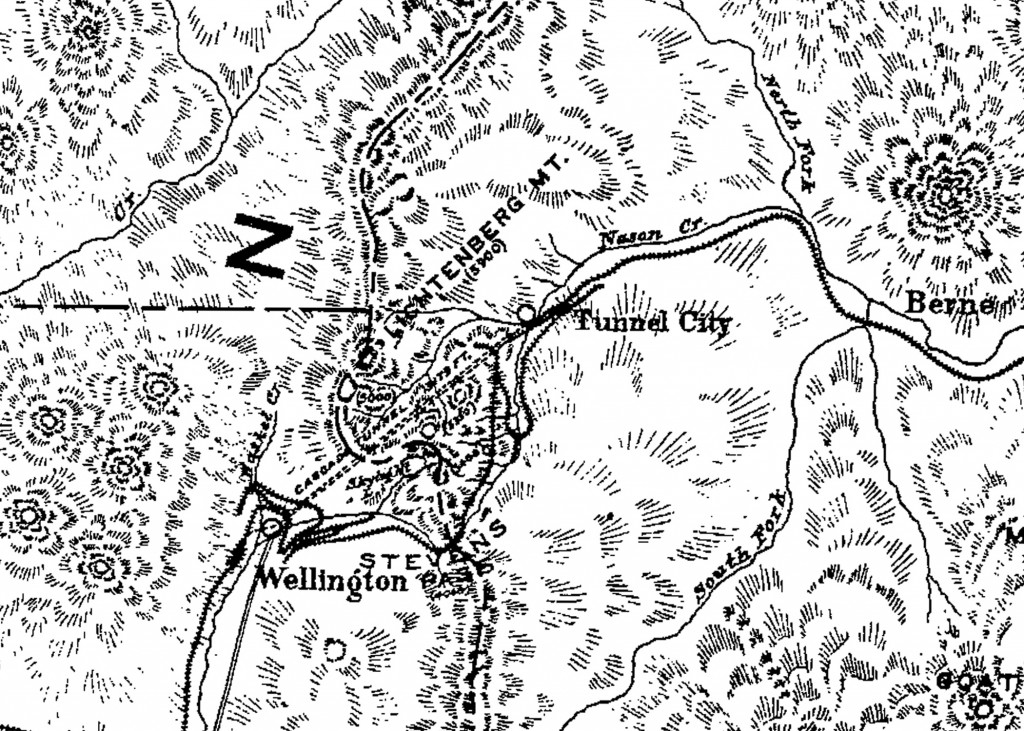Illegal Booze at Wellington
 From the desk of Steve Willis, Central Library Services Program Manager of the Washington State Library:
From the desk of Steve Willis, Central Library Services Program Manager of the Washington State Library:
Found in The Seattle Telegraph, Nov. 13, 1894, p. 8:
THE COUNTY BOUNDARY
Twelve Men in Judge Humes’ Court Define It.
ILLEGAL WHISKEY TRAFFIC
Defendants Take Refuge Behind Technical Bulwark and Escape Penalty for Their Crimes — Some Groundless Fear That the Verdict May Affect the Election Count of Martin Creek and Wellington.
“A jury in Judge Humes’ court yesterday acquitted Pat Cunningham of the charge of illegally selling liquor at Wellington, a small town on the Great Northern railway, away up in the Cascades, just at the foot of the west side of the switchback, apparently on the ground that Wellington is not in King county. A great sensation was caused by the verdict, as the greater part of the now famous Martin Creek precinct is situated on land that the jury in this case decided to be part of Kittitas county, to the east of King. It seems that last June the county commissioners discovered that a thriving business in wet goods was being done up in the Cascades, which was not bringing in any revenue to the county and they complained to the sheriff, who sent his deputy, W.B. Woolery, up to investigate the matter. Woolery found a couple of saloons running wide open, and arrested the owners, charging them with selling liquor without a license. Yesterday morning he testified to that effect, and was followed by Nathan Beman, deputy county auditor, who swore that no license had been issued to the parties, and the prosecution closed.”
“Charles F. Fishback, counsel for the defense, then called A.B. Palmer and W.L. Sanders, who had been members of a surveying party in that part of the country. They testified that Wellington is in range 13 east, township 27 north, and that the code of Washington designates the southeast corner of township 27 north range 11 east as the northwest corner of King county, which will leave Martin Creek and Wellington in Kittitas County. The jury were only out a short time before arriving at their verdict. The general opinion among lawyers is that jurors have a natural disinclination to convict men charged with such offenses and seized this straw on which to bring in a verdict of not guilty, and that on any more important case the verdict would never be sustained.”
“The truth of the matter, according to those who know, or claim to know, is that the legislature meant to set the boundary line of the county on top of the mountains curving far to the east.”
“When the verdict was brought in, the prosecuting attorney moved to dismiss a similar case against James Manson, which was granted by Judge Humes.”
“While the verdict has the effect of releasing the men charged with the crime, it cannot be taken as having any effect upon the recent voting in those precincts, or in any way disturbing the results of the election. It is the belief of prominent lawyers that on appeal such a conclusion or contention would not hold for one minute.”
“Charles Anderson, the surveyor who has made repeated surveys in that part of the country involved, says he knows in which county Martin Creek and Wellington are, and yet, strange to say, he refuses to give up any information he has on the subject. A number of newspaper men met him on Second street yesterday afternoon and asked him if he made a survey of the country. ‘Yes, I have made it,’ he said, ‘and know where it lies as to counties, but I am going to keep quiet about it for a while; I won’t say anything now about it.'”
As it happens, I found in the Washington State Library’s impressive cartographic collection a copy of Anderson’s new map of the county of King, State of Washington from O.P. Anderson & Co., a surveying firm that perhaps employed the Charles Anderson quoted above. The map dates from 1894, the same year as the trial. In this map, Wellington is very clearly in King County, near the point where it borders Snohomish and Kittitas.
The town of Wellington later became infamous in 1910 when an avalanche wiped out a train and killed over 90 people.
Judge Thomas Jefferson Humes, a Mark Twain lookalike, later became Mayor of Seattle, driving reformists crazy as he was tolerant of the city being wide open as the gateway to the Klondike gold fields.
